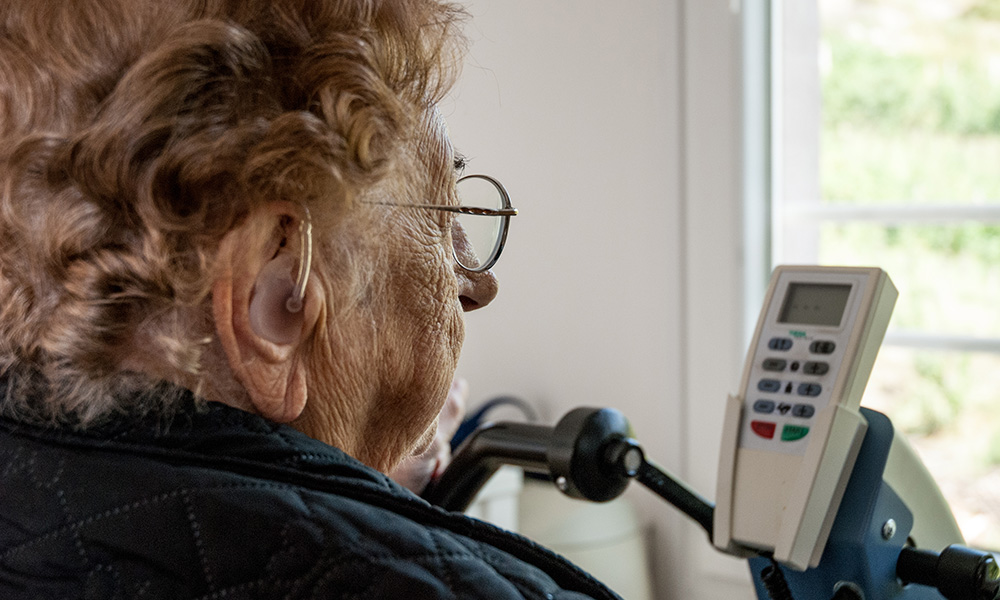
New UBCO research shows that hearing aids may help address the influence of hearing loss on physical activity.
As Canada’s population continues to age—people 65 years and older are part of the fastest-growing age group in Canada—researchers and health-care providers continue to look for ways to keep seniors as healthy as possible.
Dr. Kathleen Martin Ginis, is the Director of UBC Faculty of Medicine’s Centre for Chronic Disease Prevention and Management and a Professor with UBC Okanagan’s School of Health and Exercise Sciences. Dr. Martin Ginis recently worked with colleagues from Johns Hopkins University who led a study investigating the link between a senior’s hearing and their physical activity level.
Using data from an American National Health and Aging Trends Study, the research team studied the association of hearing loss with activity level. More than 500 participants, with a mean age of 79 years, participated by wearing accelerometers for one week and self-reporting their vigorous physical activity and walking exercise for one month. The goal was to investigate the association between physical activity and hearing loss as well as physical activity and hearing aid use. The results were published recently in The Journals of Gerontology: Series A.
Dr. Martin Ginis explains why studies like this are necessary and the important link between hearing capacity and keeping active.
Why is it important to understand the relationship between physical activity and the ability to hear well?
Hearing loss is associated with frailty, poorer physical function and falls. Low levels of physical activity are also related to these health problems. There has been very little research on whether physical activity levels and hearing loss are related in older adults, and whether the use of hearing aids makes a difference.
If we can determine that link, then health-care providers can better support older adults in maintaining an active lifestyle and researchers can focus on studying the impact of hearing interventions.
What’s the connection?
There are several potential mechanisms through which hearing loss may contribute to physical inactivity. These include a decline in the perception of environmental auditory cues while moving about, a feeling of social isolation and increased allocation of cognitive resources for listening, leaving limited attention for simultaneous tasks.
Think about the places where older adults might go to do physical activity—to community centres, public swimming pools, for walks in their neighbourhoods. If their hearing is impaired, it is going to be difficult to interact with fitness leaders or staff in these public spaces, and it may even be frightening or dangerous to move about the community if you can’t hear what is going on around you. These factors will limit a person’s activity levels.
How did you gather your data for this study?
We used data collected from a nationally representative sample of older adults in the United States. The participants had clinical-standard audiometric hearing testing and wore an accelerometer for one week to measure their physical activity levels. They also completed a couple of questions about their activity over the past month and provided information on their hearing-aid use.
What did the study determine?
We found that older adults with hearing loss did less physical activity than adults who could still hear well. As hearing loss increased, the number of minutes of physical activity performed each day decreased. The good news, however, was that among adults with hearing loss, those who used a hearing aid were more likely to report that they walked for exercise compared to those who did not use a hearing aid. These patterns held for both men and women in the study.
So, making use of a hearing aid can help keep hearing-impacted seniors more active?
Based on our findings, it seems that using a hearing aid may help to address the impact of hearing loss on physical activity. This makes sense. Hearing aid use may alleviate challenges associated with communicating with people in physical activity spaces—for instance, recreation centres and exercise programs—and reduce the cognitive processing demand in environments where the person needs to attend to auditory cues.
We hope our findings will encourage seniors to have their hearing checked on a routine basis, and if they are experiencing hearing loss, to use hearing aids. Better hearing is related to more time spent on physical activity. And physical activity has a wide range of health and function benefits for older adults.